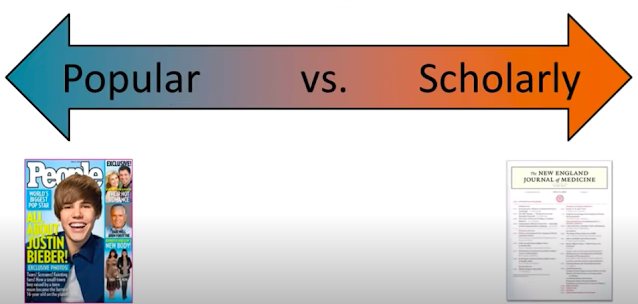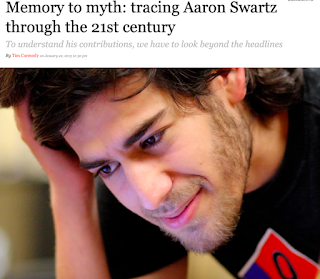Thursday, February 24, 2022
NEW MODULE Artist Statements: The Good, the Bad, and the Ugly
Tuesday, February 22, 2022
One Polished Paragraph
Today in class we'll be practicing the art of integrating secondary sources into your writing using MLA parenthetical format.
Here is a link to recent award-winning papers written by undergraduates, just like you.
Each student will have 45 minutes to write, revise, edit, and upload one paragraph that demonstrates the effective integration of a predetermined secondary source available on JSTOR in MLA format:
Thursday, February 17, 2022
Three Cheers for Scholarly Secondary Sources!
Aaron Swartz, JSTOR, and Freedom of Information
Was he right? Was he wrong? Both? Neither?
Thursday, February 10, 2022
Advice for Writing Art Criticism: Written by an Undergraduate
 And here is another piece, also written by an undergraduate, that discusses subjectivity in art reviewing.
And here is another piece, also written by an undergraduate, that discusses subjectivity in art reviewing.Tuesday, February 8, 2022
Breaking News: Extension Granted for Online Exhibition Review!
We need more time for this assignment. The new due date is Tuesday, February 15. No late papers.
Bring a paper copy of your finished draft to class this Thursday.
Basic 10-Point Rubric
I've uploaded this rubric to the "Files" tab of our Populi course page. For the most part, it's self-explanatory. I also use half-points. Please talk to me at any time if you would like clarity on your grade(s) or would like to appeal for a higher score. I'll listen and give you my honest response: csmith@dcad.edu
Here is the 10-point grading scale in condensed form:
11/10: Professional (rare)
10/10: Exemplary in every respect, high "A"
9.5/10: Excellent achievement, solid "A"
9/10: Very good, slight problems here and there, solid "B+/A-"
8.5/10: Gets all the basics right but problems creep in, "B"
8/10: OK, but shows signs of carelessness or rush job, "C+/B-"
7.5/10: Poor organization, going through the motions, "C"
7/10: Careless in most respects, doesn't follow basics, "D+/C-"
If your assignment is lower than a 7/10, you'll need to meet with me and make a plan for resubmission.
Tuesday, February 1, 2022
My Attempt at Bad Art Writing
I cobbled this together years ago in an effort to write the worst artist's statement in world history. I don't know if I succeeded, but I do know that it's really, really, really bad. A gallerist friend in DC sent me a copy of a terrible press release and that text is in the background of this one. I added to its horror. -- Casey
Artist’s Statement
I
decided to walk a path without compromises, a stormy road, the road of the
tragedy’s formalisation. My work faces an experience free of any religious or
mystical conditioning. A man who doesn’t experience eroticism to the limits of
the possible is alienated; such a man has never known my inner experience. I
look for the being who is beyond self in desire, in heartbreaking passion as
far as the extreme limits where voluptuousness and disgust meet and cancel each
other out; I use my skill as a provocative instrument, an act of indispensable
violence with the purpose of giving to art a collocation that can represent a
silent sinking of a man at his life’s peak. This is the driving force for me:
running through the forbidden kingdom of eroticism where the youthful
obsessions and the Freudian dream, the thirst for male revenge and the disgust
for saturation meet. Inside me there are unmistakable surrealist influences,
like an inclination for mental associations or for parallel (but perfectly plausible)
worlds, but the most powerful weapon is my anger. In my opinion the
representation of a nude is not an aesthetic opportunity and a sensual or
erotic form is not addressed only to educated, fragile people. Eroticism must
have a social connotation. Against the stupidity of our days, against the
offence of rationality, according to me, art can express a force that must not
be undervalued, provided that it is turned into an action by an iron will and
by a skilled hand. Through the way of degradation that I walk you can reach the
beauty of obscenity and cruelty. Along the desire borders, the kingdom of
horror begins and ecstasy can spring from it. This is the logic that annexes
art when the game of love and pleasure bore. You can interpret my naked bodies
in this sense, such as if they were hung down butcher’s hooks. This is the
undeniable world of void, the world of break up, form it derives the macabre
pleasure of the policeman Bertrand, Jack the Ripper’s morbid surgery, Landru’s
cremated bodies. It is a guided, declaimed horror that becomes attached to the
body object and that now is at the image disposal. Love gets closer to death in
a road freckled of attempts, the way to initiation, but in the end you do not
reach the promised garden of delight nor do you discover the treasure of the
legend but the frightening abyss of nothing. This obscene beauty, this pain’s
orgasm, lighted also by the light of despair, is expressed in the macabre
representations and must be interpreted as a figurative answer, a pictorial
nemesis of the suffered violence. At that time, and today, a spectator, a
voyeur, who only desires to be hit, observes secretly the scene. It is obvious
that for Del Piombo, Holbein, Michelangelo, Correggio, Artemisia, Munch,
Bellmer, Bacon or me, eros and thanatos are just one thing.
I was born in Pasadena in 1965.
I now live in Washington, DC, where my atelier is established. In my youth, I began
to paint reproducing the masters in an instinctive journey of research and
acquaintance through the several passages of the history of expressive art, as
if my personal psychology and nature dictated the road that I would then have
to cover in the future. During this journey I matured a deep knowledge of great
valence, not only representative or figurative, that the artistic expression
has on the human being, and this has lead me through various fields of research
that cross different art forms. In this continuous study and in-depth
investigation the natural artistic evolution and the choice of the techniques
lead me to privilege painting in acrylic, oil, and watercolour. But the always
curious spirit of expressive alternatives and striving for learning new
artistic communication forms, that always subtends to any choice I make and
that expresses the versatility of my personality, takes me to approach and to
experience other aspects of art as creations with words, clay, wood, ceramics,
and artistic installations. From the sum of all these aspects of my personality
and experiences, I therefore gain the instinctive ability to render life, the
human society and beings and to create works that express my vision and look on
the world in a straight way, emotionally strong, sometimes in a raw and
realistic way, sometimes in a dream-like way, other times in a nearly disarming
way for the simplicity with which I succeed in expressing my emotions. The
theme that I prefer to face and to express in my work is that of the decadence
of the western human being and societies and models, addicted to the spasmodic
research and exploitation of appearance, of
individual profit as the only value to pursue, hardly lost in the mazes
of a nihilistic and exclusively self-referring psychosis, and by now incapable
of arising again to themselves and to the world with that creative, positive
and renovating force that should characterize actions, thoughts and evolution
of human beings. It’s the metaphysical vision, sad nevertheless strong and
determined, of these aspects of reality and of these contrasts not only social
and political, but also strongly emotional and psychological, the creative
field in which my work in is born. The study and the research of new materials,
expressive forms, new levels of sensibility and thought always continues and
will always be the base of every work and job of the artist. Restless and strong, since adolescence the possibility
to express myself through art, with my pictures, without any indulgence or
rhetoric, has been my sole goal. I want to explore the intimacy not resolved which
lodges in everyone of us and to point out the degeneration that modern society
is suffering. On my canvas you find represented extreme situations, to the
limit of what could be defined “forbidden”, exposed with sharp language, thus
like the clearness and the accuracy of the details are the syntax chosen by me in
order to arrive to an opened and clear exploration of the deformation of the
human being. The repudiation of nature itself of the human being is exactly the
fulcrum of the metaphoric speech of the artist that describes the individual as
an entity that should distinguish himself for intellect and sensibility,
reduced instead to hybrid, between man and beast, destined to an eternal
dissatisfaction and vanity. The victim and
the predator, wolf and lamb, do not show themselves like undistinguished
personages that may be recognized for their identity, but hidden under a veil
of uncertainty and animated by the controversial strength of the surrealistic
reality in which they entered, they find themselves to feature confused roles, as
actors who carry the spectator to doubt every appearing truth. The research of “The Ego” taken by the artist has the
scope to find again those human qualities and those lost feelings, leaving from
the often alarming representation that the mind dictates: love, physical
attraction, vendetta, mercy, ambition, abjection, indifference are strictly
connected and often difficult to distinguish, because multiple sides,
overlapped, of a unique world. The truth becomes therefore interpretable in as
many ways, a relative truth that does not follow any moral. Here, therefore, is revealed the objective of the
artist: the difficult denunciation of the daily actuality of the perverted, the
unsolved way towards a socially shared distinction between good and evil and,
above all, the research of an absolute justice, not only looking as good,
neither indulgent, but that coincide with the good… good represented through an
extraordinary vision set free from every moralistic infrastructure.
Casey Smith
Intentionally Bad Art Writing Is Fun, but Great Writing is Inspiring: Introducing John Yau
Short Essay #2: Menu of Online Art Exhibitions
Spend an hour or two exploring these online exhibitions. Let me know if the links don't work. This is part of your homework. Enjoy learning about new artists and designers. Take notes about certain features of particular online exhibitions that are pleasing, distracting, smart, stupid, etc.
1. Hung Liu: Portraits of Promised Lands, 1968-2020
https://www.si.edu/exhibitions/hung-liu-portraits-promised-lands-1968-2020:event-exhib-6513
2. Printing the Revolution! The Rise and Impact of
Chicano Graphics, 1965 to Now
3. Willi Smith: Street Couture
https://willismitharchive.cargo.site/
4. John Singer Sargent: Portraits in Charcoal
https://www.si.edu/exhibitions/john-singer-sargent-portraits-charcoal:event-exhib-6291
5. James Van Der Zee’s Photographs: A Portrait of Harlem
https://www.nga.gov/exhibitions/2021/james-van-der-zee-photographs-portrait-harlem.html
6. Artist Projects: Sarah Cain, Avish Khebrehzadeh, Kay
Rosen
https://www.nga.gov/exhibitions/2021/artist-projects-sarah-cain-avish-khebrehzadeh-kay-rosen.html
7. Inspiring Walt Disney: The Animation of French
Decorative Arts
https://www.metmuseum.org/exhibitions/listings/2021/inspiring-walt-disney
8. Charles Ray: Figure Ground
https://www.metmuseum.org/exhibitions/listings/2021/charles-ray
9. Jasper Johns: Mind/Mirror (two venues)
Whitney Museum of American Art:
Philadelphia Museum of Art:
https://philamuseum.org/calendar/exhibition/jasper-johns-mindmirror
10. Celebrating 150 Years of “Alice’s Adventures in
Wonderland”
https://exhibitions.lib.umd.edu/alice150
11. Viral Self-Portraits (group exhibition)
https://www.mg-lj.si/en/online-exhibitions/2888/viral-portraits/
12. Lorna Simpson: Give Me Some Moments
https://www.vip-hauserwirth.com/online-exhibitions/lorna-simpson-give-me-some-moments/
13. Mary Ellen Mark: Girlhood
https://nmwa.org/whats-on/exhibitions/online/mary-ellen-mark-girlhood/
FAQ: The Academic Essay
I've been teaching college writing for a very long time, and through these years I've noticed certain enduring issues that students ...
-
First Year Students! Sending you a reminder that you need to sign up for your first-year portfolio presentation. The sign-up is live. Bel...
-
With the conclusion of the Zine project, we have reached the end of the first unit of the class: 1. "Self" is over. 2. "Comm...
-
This assignment is fairly straightforward. Please follow these directions carefully. You will be writing a focused mini-essay of approxima...











